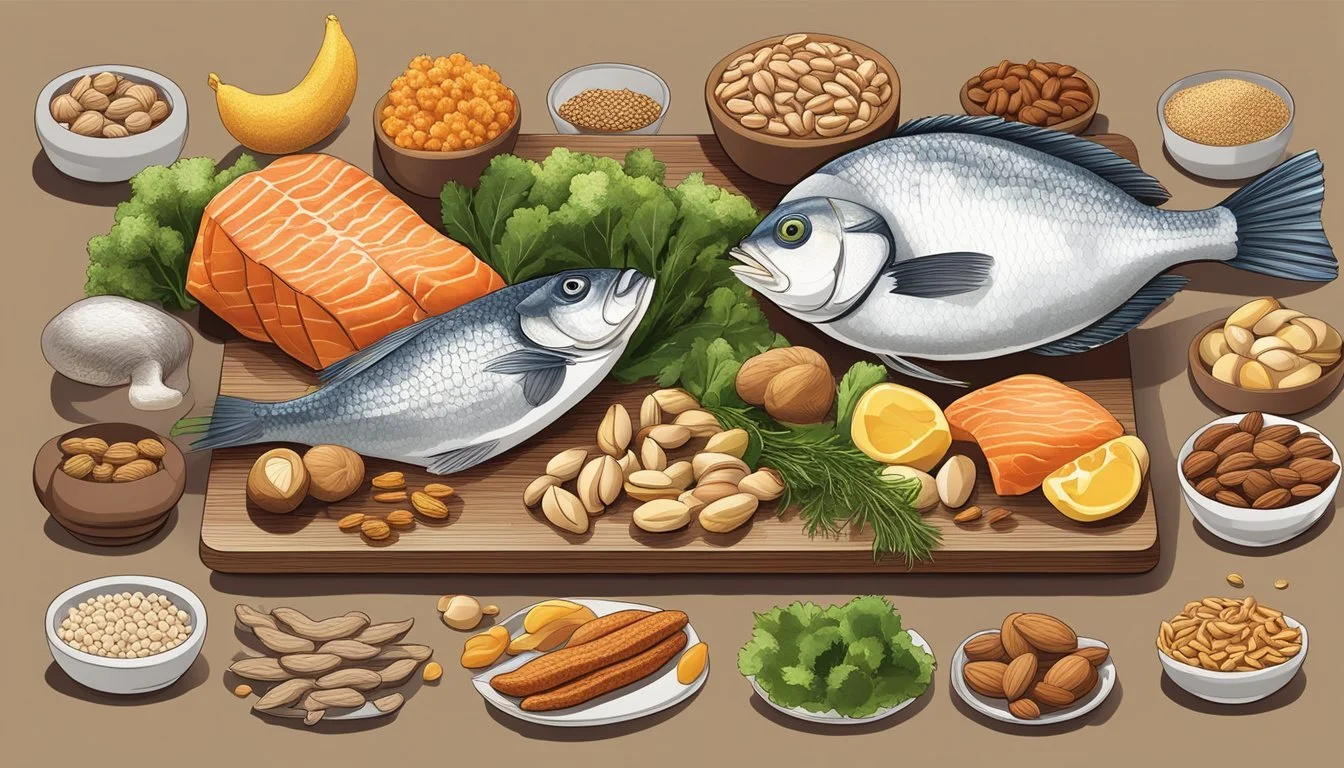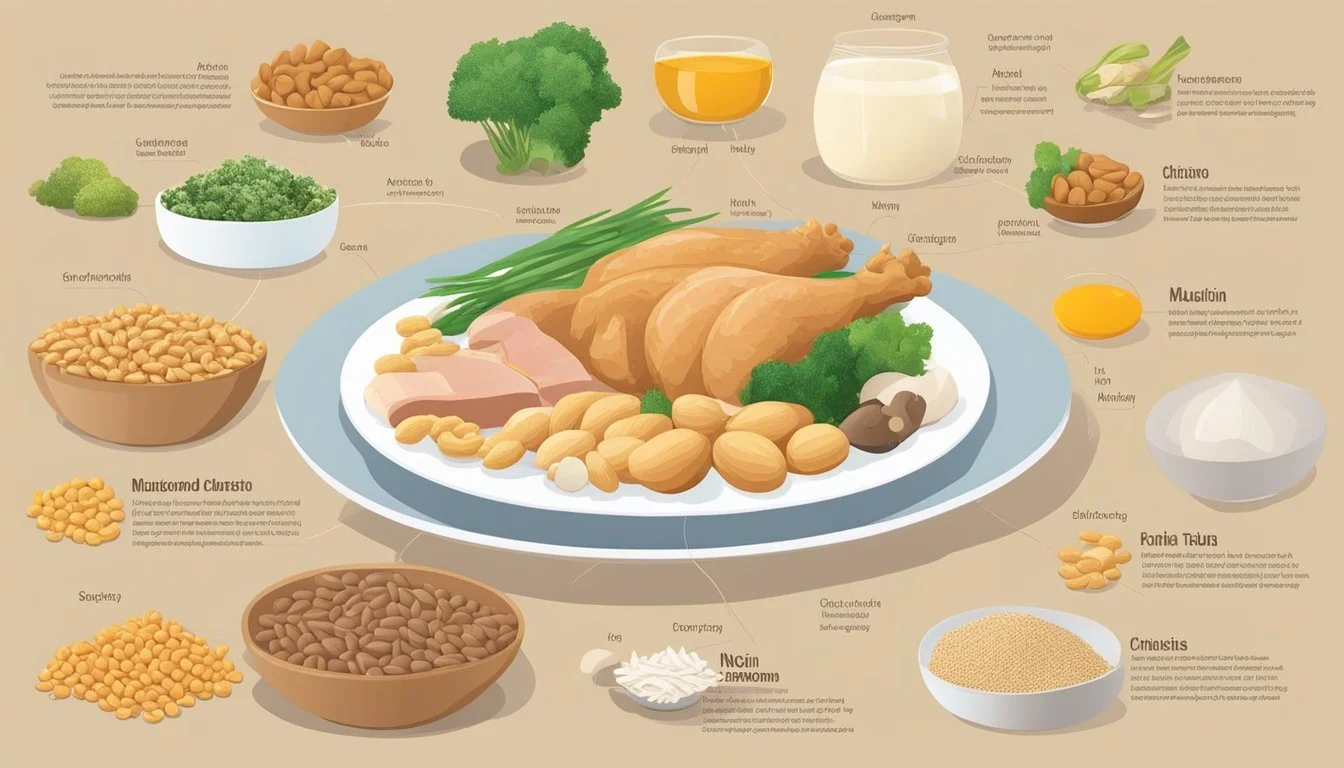How Much Niacin-Rich Foods Benefit Energy Production
Understanding Optimal Intake
Niacin, or vitamin B3, plays a pivotal role in energy production within the body. This essential nutrient aids in the conversion of food to energy by being a central component of NAD and NADP, two coenzymes involved in cellular metabolism. It is therefore important for maintaining healthy brain function and an effective metabolism. Niacin is also important for the nervous and digestive systems, as well as skin health.
Individuals can obtain niacin through a variety of foods, ensuring they meet their daily nutritional requirements. For optimal health benefits, adults should aim to consume approximately 14-16 milligrams per day for men and 12-14 milligrams per day for women. Niacin-rich foods include liver, meat, fish, peanuts, whole grains, and fortified foods. For those following a vegetarian diet, portobello mushrooms are a particularly rich source of this vitamin.
The integration of niacin-rich foods into a balanced diet supports not only cognitive functions but also contributes to overall energy levels. Because the body can also convert certain amino acids, like tryptophan found in protein-rich foods such as milk, cheese, and eggs, into niacin, a varied diet usually covers the recommended intake. However, monitoring niacin intake is important, as both deficiency and excessive consumption can lead to health issues.
Understanding Niacin and Its Role in Energy Production
Niacin, also known as vitamin B3, is a vital nutrient that serves as a cornerstone for energy production within the human body. It's a key player in metabolism, aiding the conversion of proteins, fats, and carbohydrates into usable energy.
The Functions of Niacin
As part of the B vitamins group, niacin assists in the functioning of enzymes that are fundamental to metabolic processes. It specifically contributes to the formation of NAD (nicotinamide adenine dinucleotide) and its phosphate form, NADP. These coenzymes are essential for over 400 enzymatic reactions, many of which are related to energy production.
Niacin Sources
Dietary niacin comes from various foods, including meats, fish, nuts, and certain grains. The body can also synthesize niacin from the amino acid tryptophan.
Energy Metabolism and Niacin
During energy metabolism, niacin-containing coenzymes, NAD and NADP, are involved in oxidative reactions, where nutrients from food are broken down and their stored energy is released. This process is crucial in the Krebs cycle, a sequence of reactions generating ATP (adenosine triphosphate), the primary energy currency of the cell.
Requirements and Physical Activity
Niacin requirements are commonly measured in milligrams of niacin equivalents (NE). These account for both the niacin obtained through diet and that synthesized from tryptophan. One's energy needs, influenced by caloric intake and physical activity levels, determine the recommended niacin intake.
In summary, niacin's key role in energy production underscores its necessity in a balanced diet and maintaining robust metabolic health.
Recommended Dietary Allowance for Niacin
The Recommended Dietary Allowance (RDA) for niacin is determined by various demographic factors and is essential for optimal energy production in the body.
RDA for Different Demographics
Adult Men: For men aged 19 years and older, the RDA for niacin is set at 16 milligrams (mg) daily.
Adult Women: Women aged 19 years and older should aim for 14 mg of niacin daily. During pregnancy, the requirement increases to 18 mg daily, and for breastfeeding women, it is 17 mg daily.
Children and Adolescents: The RDA for niacin varies by age:
Ages 1-3: 6 mg daily
Ages 4-8: 8 mg daily
Ages 9-13: 12 mg daily
Adolescents 14-18: 16 mg daily for boys and 14 mg daily for girls
Older Adults: The RDA for adults over 50 generally remains the same as for other adults, although individual requirements may change based on health conditions and medication use.
Factors Affecting Niacin Requirements
Genetics and Health Conditions: Certain genetic conditions and health issues can increase the need for niacin. Those with conditions that affect nutrient absorption may require more niacin.
Dietary Intake: Individuals with diets lacking in diversity or those with eating habits that do not include enough niacin-rich foods may need supplements to meet their RDA.
Alcohol Consumption: Excessive alcohol intake can lead to niacin deficiency, necessitating an increased intake to meet the RDA.
Medication Interaction: Some medications can impact niacin levels, either by increasing requirements or affecting absorption. Always consult with a healthcare provider before taking niacin supplements, especially if other medications are being used.
Benefits of Niacin Beyond Energy Metabolism
While niacin is well-known for its role in converting food into energy, it also imparts significant benefits to other biological functions. These include enhancing cardiovascular health, maintaining healthy skin, and supporting optimal brain function.
Cholesterol and Cardiovascular Health
Niacin has a pronounced effect on cholesterol levels. It is capable of increasing HDL (high-density lipoprotein) cholesterol, which helps to remove other forms of cholesterol from the bloodstream. Concurrently, niacin can aid in lowering LDL (low-density lipoprotein) cholesterol and triglycerides, which are linked to heart disease. However, provision of niacin for cholesterol management requires medical oversight to ensure safe and effective use.
HDL Cholesterol: Boosting beneficial
LDL Cholesterol: Reduction implicated
Triglycerides: Clinically observed decrease
Skin Health and Protection
Niacin, particularly in the form of niacinamide, contributes to skin health by providing protection against environmental damage, reinforcing the skin's barrier, and exhibiting anti-inflammatory properties. It can also help the skin retain its moisture, contributing to its health and preventing a range of dermatological issues. Moreover, niacin's antioxidant properties help protect the skin from oxidative stress which can lead to premature aging.
Barrier Function: Strengthened
Hydration: Improved
Oxidative Stress: Antioxidant mitigation
Brain Function and Mental Health
The brain relies on niacin due to its involvement in producing energy at the cellular level. Niacin supports neurotransmitter functions critical for mental health and has been associated with potential protective effects against cognitive decline. It's noteworthy that adequate niacin levels are essential for maintaining brain function; however, findings are still unfolding regarding its full impact on cognitive health and disease prevention.
Neurotransmitter Support: Fundamental
Cognitive Health: Potentially advantageous
Food Sources of Niacin
Niacin, or Vitamin B3, is essential for energy production in the body and is abundantly available in a variety of foods. They are pivotal for maintaining good health and can be found widely across both animal and plant sources, as well as in fortified products.
Animal-Based Niacin-Rich Foods
Foods deriving from animal sources provide a substantial amount of niacin. A spectrum of meats is known to be particularly rich in this nutrient:
Liver: Beef liver stands out as an especially concentrated source of niacin.
Fish: Particularly, tuna (What wine goes well with tuna?) and salmon (What wine goes well with salmon?) are high in niacin, providing a dual benefit of omega-3 fatty acids.
Poultry: Chicken and turkey breasts are not only high in niacin but also provide lean protein.
Portion examples with niacin content:
Food Niacin Content Beef Liver 14.9 mg per 3 oz Chicken Breast 11.4 mg per 3 oz Turkey Breast Approx. 10 mg per 3 oz Salmon 8.5 mg per 3 oz Tuna 22.1 mg per 3 oz
Plant-Based Niacin-Rich Foods
Plant-based foods also offer niacin, often accompanied by fiber and other nutrients:
Peanuts: A good plant-based source of niacin and protein.
Whole Grains: A natural component of many grains, though refining can reduce niacin content.
Green Peas: These legumes contain a fair amount of niacin and are common in many diets.
Typical serving size niacin values for plant foods:
Food Niacin Content Peanuts 4.2 mg per 1/4 cup Cooked Green Peas 3 mg per 1 cup Whole Wheat Bread 2.4 mg per slice
Fortified Foods and Their Role
Fortification is the process of adding nutrients to foods, which can significantly increase the niacin content:
Breakfast Cereals: Many cereals are fortified with niacin and other B-vitamins.
Enriched Flour: Used in a range of bread and baked goods, contributing added niacin.
Such fortified foods can help to prevent dietary deficiencies of niacin and ensure adequate intake across different dietary patterns.
Supplementation of Niacin
Niacin supplementation can be an essential approach in specific circumstances where diet alone does not meet the body's requirements for energy production and other health needs.
When is Supplementation Necessary?
Supplementation with niacin is necessary in situations where individuals have certain health conditions that lead to niacin deficiency or have increased requirements that cannot be met through diet alone. Such conditions may include:
Digestive disorders that impair absorption of nutrients
Long-term use of certain medications
Genetic metabolic disorders
Poor dietary habits leading to insufficient intake
Individuals who are at risk should consult with a doctor to determine the need for niacin supplements and to ensure safety and appropriateness of usage.
Choosing the Right Niacin Supplement
When selecting a niacin supplement, one should understand that supplements come in different forms such as nicotinic acid and niacinamide, both of which have different effects. Nicotinic acid primarily affects cholesterol levels, whereas niacinamide does not — making it a preferable option for those focusing on niacin's benefits for energy production without the cholesterol-lowering effects. Additionally, some niacin supplements may cause flushing, a common side effect that can be minimized with extended-release formulations.
When choosing a niacin supplement, consider the following:
Supplement Form: Be aware of the form of niacin, either as nicotinic acid or niacinamide.
Dosage: Ensure the dosage is appropriate and consult a healthcare professional for advice.
Quality: Look for high-quality, third-party verified supplements to ensure purity and potency.
It is critical to follow the guidance of a healthcare professional for dosing and to monitor for potential interactions with other medications and for any adverse effects. Regular monitoring by a healthcare professional ensures supplementation is done safely and effectively.
Potential Health Risks and Side Effects of Niacin
While niacin plays an essential role in energy production and offers health benefits, excessive intake can lead to significant side effects and health risks.
Recognizing Niacin Overdose Symptoms
Niacin overdose, which might occur from high supplement intake, can cause serious health issues. Symptoms of an overdose include:
Severe skin flushing combined with dizziness
Rapid heartbeat
Itching or burning sensation
Nausea and vomiting
Abdominal pain or diarrhea
If someone experiences these symptoms, especially after taking high doses of niacin supplements, they should seek medical attention immediately as it can lead to more severe complications such as liver damage, gout, or even death in extreme cases.
Managing Niacin Flush and Other Reactions
Niacin flush is a common side effect characterized by:
Warmth
Redness
Itching or tingling of the skin
Typically, a niacin flush occurs with doses as low as 30 mg and can last a couple of hours. To manage a mild niacin flush:
Start with lower doses of niacin and gradually increase as advised by a healthcare provider.
Take niacin with food to slow down its absorption.
Opt for extended-release niacin formulations, as they are less likely to cause flushing.
On the other hand, if a person experiences more severe reactions like liver problems, high blood sugar, or gastrointestinal issues, they should consult with a healthcare professional to adjust their niacin intake accordingly. Regular monitoring can prevent the long-term side effects associated with excessive niacin consumption.
Interactive Role of Niacin and Other Nutrients
Niacin, or vitamin B3, is pivotal in energy production, working in concert with other nutrients to support metabolism. This section explores how niacin's effectiveness is enhanced when combined with other B vitamins and how it interacts with essential minerals and amino acids.
Synergy with Other B Vitamins
Niacin functions best within the B vitamin complex where it works alongside riboflavin (B2), vitamin B6, and vitamin B12. Each of these contributes to the body's energy production. For instance:
Riboflavin is integral to the electron transport chain that generates cellular energy. Without sufficient riboflavin, niacin cannot effectively participate in metabolic processes.
Vitamin B6 assists in the conversion of food into energy and is necessary for niacin to perform its role in the synthesis of fatty acids and cholesterol, which are important for cell function.
Vitamin B12 is crucial for red blood cell formation, which is necessary for transporting oxygen to cells for energy production.
Niacin's Interactions with Minerals and Amino Acids
Niacin's role in energy metabolism also extends to its interactions with various minerals and amino acids:
Magnesium is a co-factor for enzymes that require niacin. Adequate magnesium levels ensure these enzymes function correctly to metabolize carbohydrates and fats for energy.
Zinc works with niacin and other enzymes to support the immune system, and proper zinc levels may enhance niacin's effects on cellular energy production.
Iron is essential for oxygen transport in the blood, supporting niacin's role in energy release from cells.
An amino acid called tryptophan can be converted into niacin in the body, linking protein intake directly to niacin availability.
In summary, the presence of minerals such as iron, zinc, magnesium, phosphorus, potassium, and selenium, along with nutrients like choline and other B vitamins, is essential to maximize niacin's role in energy production. They work in a coordinated manner to facilitate the complex biochemical processes necessary for maintaining energy levels in the body.
Dietary Strategies for Optimizing Niacin Intake
Ensuring adequate niacin intake is crucial for energy production and overall health. This section provides strategies to include niacin-rich foods in one's diet effectively.
Balanced Diet Approach
A balanced diet naturally includes a variety of niacin-rich foods that can help meet the body's nutritional needs. Individuals should focus on consuming a mix of legumes, lean meats, fish, whole grains, and green vegetables. For instance, legumes such as lentils and chickpeas, not only provide niacin but also are a great source of fiber and protein, supporting overall dietary balance.
In addition, incorporating seeds and nuts can provide additional niacin benefits. Avocado—a fruit high in niacin—can be included in the diet in various ways, such as in salads, sandwiches, or as a healthy spread to replace less nutritious options.
Meal Planning with Niacin-Rich Foods
Successful meal planning requires incorporating foods that are high in niacin into daily menus. Here’s a brief meal plan showcasing how to integrate niacin-rich foods:
Breakfast: A smoothie with avocado and a handful of sunflower seeds.
Lunch: A turkey or chicken salad with spinach, adding chickpeas for a niacin boost.
Dinner: Grilled salmon (What wine goes well with grilled salmon?)or tuna, which are excellent sources of niacin, served with quinoa and steamed broccoli.
To ensure niacin intake is spread out throughout the day, snacks can include peanuts, almonds, or peanut butter on whole grain toast.
By thoughtfully including niacin-rich foods across all meals, individuals can support their energy production needs and maintain a healthy, balanced diet.
Conclusion
Niacin, or vitamin B3, is integral for the body's energy production as it aids in converting food into usable energy. It is essential for maintaining cardiovascular health and skin health, with its benefits extending to various cellular processes. The Recommended Dietary Allowance (RDA) for niacin varies; adults should aim for about 14 to 16 mg per day, though this can differ depending on age, sex, and health status.
Including niacin-rich foods in one's diet is generally beneficial, as these present a natural way to support overall health. The sources of niacin are diverse:
Meat: Beef, pork, and poultry
Fish: Tuna and salmon
Legumes: Peanuts
Grains: Whole and fortified cereals
The body also synthesizes niacin through the amino acid tryptophan, found in protein-rich foods like milk, cheese, and eggs. Ensuring a diet incorporating these niacin sources can support the body's energy production pathways effectively.
While niacin supplementation is available, it is advisable to seek guidance from healthcare professionals to avoid excessive intake, as high doses can lead to side effects like nausea and liver issues. Balancing one's diet to include niacin naturally may yield positive results for energy production and overall well-being.








